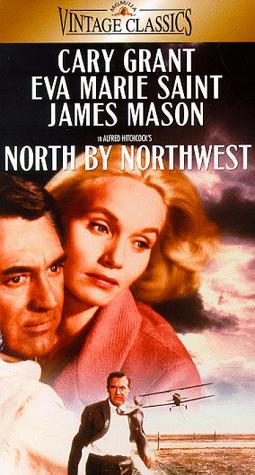 Study
Questions: Week Four
Study
Questions: Week Four  Study
Questions: Week Four
Study
Questions: Week Four
On the Run from the Threatening "Other"
The Man Who Knew Too Much (1956)
North by Northwest (1959)
In addition to appropriating the technical innovations of the Hollywood film during the 1950s, Hitchcock also drew on the socio-political concerns of the era. The Cold War offered settings for many films about international intrigue, and Hitchcock made good use of this popular film genre. His two best films, however, used the Cold War as background for his familiar subjects and themes such as mistaken identity, characters pursued for no apparant reasons, the malign hature of governmental powers, and the problematic nature of romantic love and conjugal life. His two films more explicitly about the conflict between East and West, Topaz and The Torn Curtain, are decidedly inferior errorts.
The Man Who Knew Too Much: Dangerous Secrets
1. How does Hitchcock use the opening sequences (up to the murder of Gelin) to show how even the most innocent individuals can be caught up in destructive forces?
2. Are there similarities to the previous Jimmy Stewart heroes we have seen in the character of Dr. Ben McKenna?
3. How does the film exploit three aspects of Hollywood film making in the 1950s: the wide screen, color, and shooting on location rather than in a studio? How might these techniques be seen as an answer to television's increasing popularity?
4. What contributes more to the film's suspense, the discovery of the identities of the murderous espionage agents of the search for the kidnapped son? If you were to classify the film by genre, would you call it an espionage film or a domestic melodrama?
5. How does Ben's treatment of his wife (Dorid Day) after the kidnapping of Hank (Christopher Olsen) reflect gender attitudes of the 1950s?
6. Why might Jo's singing "Que Sera Sera" be seen more as a distraction than an addition to the plot?
7. Exactly which nations are involved in the spying and assassinations are never made clear. It this a fault in the plot, or is there some significance in having both friends and enemies resemble one another?
8. How does Hitchcock use the camera to build suspense in the Albert Hall sequence?
North by Northwest: Mistaken Identities.
1. In what ways does North reflect Hitchcock's turning away from plots and circumstances rooted in family/domestic conflicts to one rooted in Cold War politics?
2. To what degree does the power of this film depend on memorable sequences rather than on a strongly integrated narrative?
3. What do you make of the relationship between Thornhill and his mother? How is it both similar to and different from the mother/son relationship in previous films.
4. How does Hitchcock treat the U.S. Intelligence Agency and its leaders? How do they treat U.S. citizens? Are we, the audience encouraged to admire or condemn?
5. Is the whole "Kaplan" business, which drives the plot from episode to episode a real exploration of the world of espionage? Or is the whole spy business a McGuffin, an excuse to explore the themes of guilt, mistaken identity, and dread that are familiar in Hitchcock's other films? To put it another way, is Cold War politics here analogous to Freudian psychology in Psycho?
6. What is the meaning of the title? How is it related to the action and themes of the film?
7. This film is famous for two episodes: the attack of the crop-dusting airplane nad the chase across the faces carved into Mt. Rushmore. What about them seems to attract so much admiration? How do they both create tension by defamiliarizing the normal and commonplace?
8. Is there anything you find disturbing in Hitchcock's love scenes, anything which suggests his ambivalence toward the erotic and the sexual?
9. Does Hitchcock make fun of his hero and even of the thriller as a genre? In what ways might North be an ironic comment on the directors favorite themes and chatacter types?
10. In what ways is Eva Marie Saint an embodiment of the Hitchcock heroine?